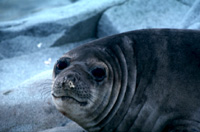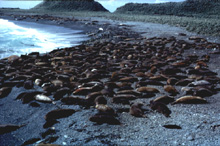This page is in the process of being created.
Southern Elephant Seal
(Mirounga leonina)
IUCN STATUS (2011) - LEAST CONCERN



Photos: Tom Arnbom, University of Stockholm
Distribution and numbers
The Southern elephant seal is circumpolar in distribution, being found on most of the subantarctic islands, including the Falkland islands, Gough, Marion and Prince Edward islands to the south of S. Africa and the Macquarie and Auckland islands to the south of New Zealand. They will haul out on ice or snow, and rocky or grassy terrain, but their preferred habitat is sandy or cobble beaches north of the mobile pack ice (King, 1983). The current total population size is unknown, but was estimated at around 650,000 in the mid-1990s (Campagna, 2008). Traditionally there were thought to be three distinct populations (S. Georgia, Macquarie and Prince Edward/Iles Kerguelen, but it is now thought there are at least five distinct groupings. The largest breeding colony is currently at South Georgia (Campagna, 2008).
Conservation Status
The S. Georgia population is stable or still growing. However other colonies in the Southern Indian and Pacific Oceans have reduced by 50% over the past 50 years, with reduced food supply being suggested as a possible reason for this (Campagna, 2008). The Spouthern elephant seal was hunted for thousands of years by native peoples. However, after the discovery of S. Georgia by Captain Cook in 1775, intensive indiscriminate slaughter - first of fur seals and then, when their numbers were depleted, of the elephant seals. The hunters almost exterminated the seals on S. Georgia, and then the hunt waned at the end of the 19th century because it was no longer profitable. A licensed hunt was introduced from 1910 band this did not end until 1964, since when there has been no hunting permitted. Any future hunting within the area (S. of 60°) would be regulated by the international Convention for the Conservation of Antarctic seals, while north of this area the Convention on Antarctic Marine Living Resources would apply. The Falkland Islands provides protection for the seals n South Georgia and and South Sandwich islands.The Southern elephant seal is listed on CITES Appendix II (Campagna, 2008).
The other main identified threat is depleted fish stocks, which appears to affect some populations more than others.
Life history
The basic life history of the Southern elephant seal is described by Ling and Bryden (1981) and King (1983). The breeding season starts in September with the breeding bulls coming ashore. The breeding females then come ashore, who wander about and gradually assemble into groups. As more females arrive, harems form around the males, with female groups increasing up to 20–40 females. The pups are born mostly in October. There is considerable variation on the size of pregnant females, ranging at S. Georgia from 296–977kg (Arnbom et al., 1994). The larger females give birth to larger pups, and the larger pups were more lkely to be male, since male pups were about 9–17% heavier than female pups. The smallest females tended to gve birth to female pups (Arnbom et al., 1994). The females are ready to mate when the pups are about 18 days old, and the harem bull wiill mate with the females in his harem. Younger bulls who do not have a harem will hover around the edge of the harems waiting for a mating opportunity, and sometimes challenging the harem bull by roaring and posturing. After weaning the pup, at around 23 days, the females return to sea. As in other phocid species, there is a delayed implantation of the embryo, but the free blastocyst stage has been reported to last 16 weeks, which is longer than in most phocids and would imply a period of only about 7 months foetal development.
Pup suckle about 10 times a day at the beginning of lactation, totaling about 25 min per day, but this increases to about 20 times a day with an amazng 180 min per day suckling time! Weaning weight is highly variable, with some pups three times as heavy as others at weaning. Pup weaning weight is related to maternal weight (Arnbom et al., 1993). Pups fast ashore for 21–66 days before going to sea. Immediately after weaning pups move to the edge of or away from the harems. They tend to stay ashore during the day and go into the water at night gradually spending more time in the water, either fresh water ponds or the sea. Heavier pups stayed ashore for longer than lighter pups. During this post-weaning onshore period they lose more than 30% of their weaning mass. The finction of the long onshore period may be for pups to develop their swimming and diving and foraging skills during their trips into the water while they still have enough blubber to witstand their intial low success at catching prey (Arnbom et al., 1993).
The newly weaned pups tend to gather in groups of 2–67, median size 3 pups (Modig et al., 1997). They spend 97% of their time ashore resting. As the pups go in and out of the water, mainly at dusk and dawn, the male pups sometimes engage in 'mock fighting' play, but female pups did not participate (Arnbom et al., 1993; Modig et al., 1997). Occasionally a male pup was seen lying beside a female pup holding a flipper over her. The pups are usually active when in the water, playing and swimming. While they are resting during ths period it appears that their metabolic rate is lowered. thereby conserving energy. Staying ashore, resting during the day may increase vitamin D synthesis, necessary for calcium metabolism and bone remodelling, which takes place durng the post-weaning fast (Modig et al., 1997).
Juvenile southern elephant seals and adult seals outsdie the breeding season move widely about the southern oceans, undertaking long-range migrations. Three adult females at S. Georgia, fitted with satellite transmitters and time-depth recorders (TDRs), were found to travel up to 2650 km, travelling ~85km per day for 16–23 days to specific distant areas of the Antarctic continental shelf where they engaged in foraging. The foraging areas are readily locatable oceanographic features, such as the Continental shelf or the Antarctic Polar front. It is thought that one reason for these long firaging migrations is that the local shelf area round S. Georgia cannot sustain the elephant bseal population that breeds there (McConnell et al., 1992). Twenty adult female and subadult male seals from the small, remote colony at Bouvetøya (in the Atlantic Southern Ocean) were fitted with transmitters and TDRs in February 2008, after the breeding and moulting period (Biuw et al., 2010). The seals feeding in pelagic ice-free waters in the summer were found to dive to 500–1500m during the day, and less deep at night; this diving pattern is probably related to vertical migration patterns of their prey species. When foraging under the winter sea ice, their dives were found to be 500–700m, and the seals were probably feeding on the sea bed. Six of the seals fed along the continental shelf were feeding on the seabed, diving to depths of 400–500m.
Vital statistics
The southern elephant seal is the largest species of seal. Adult males range from about 4.5 m to 5.8 m in length, and weigh from about 1,500 up to as much as 3,700 kg. The males have an inflatable proboscis, which gives the name 'elephant seal', though the proboscis is only fully developed in adult males. Adult females are much smaller, weighing from 350kg up to 900kg, and have no proboscis (King 1983; Campagna, 2008). Newborn pups are about 1.3 m and 45-50 kg, and gain up to 9 kg/day (Laws, 1953, cited by King, 1983; Ling and Bryden, 1981) and the nursing period lasts for an average of 23 days. Pups are born in a long woolly black lanugo coat that is moulted from about 10 to about 34 days old (King, 1983), and do not enter the sea until this moult is complete. The new coat of the moulted pups is silver gray dorsally and yellowish gray ventrally (Campagna, 2008). Females reach sexual maturity between 3 and 5 years and are expected to have about 7 pups in their lifetime of up to about 14 years. Males reach sexual maturity at an age of 4 years, but would probably not mate until the age of about 10, and live to be abut 20 (Jones 1981; cited by Campagna, 2008).
Internet links
Juvenile elephant seal interacts with human visitor at South Georgia.
'How to cuddle with an elephant seal' - Juvenile elephant seal interacts enthusiastically with human visitor to South Georgia!
These clips show how charming and delightful young elephant seals are, and these human visitors seemed to be taking great care not to disturb the seals or to impose themselves on the animals. Care should always be taken to ensure that tourism is non-intrusive, and follows careful guidelines.
References
Arnbom, T., Fedak, M.A., Boyd, I.L. and McConnell, B.J. (1993). Variation in weaning mass of pups in relation to maternal mass, postweaning fast duration and weaned pup behaviour in southern elephant seals (Mirounga leonina) at South Georgia. Can. J. Zool. 71: 1772–1781.
Arnbom, T., Fedak, M.A. and Rothery, P. (1994). Offspring sex ratio in relation to female size in southern elephant seals, Mirouga leonina. Behav. Ecol. Sociobiol. 35: 373–378.
Biuw M, Nøst OA, Stien A, Zhou Q, Lydersen C, et al. 2010 Effects of Hydrographic Variability on the Spatial, Seasonal and Diel Diving Patterns of Southern Elephant Seals in the Eastern Weddell Sea. PLoS ONE 5(11): e13816. doi:10.1371/journal.pone.0013816
Campagna, C. (2008). Mirounga leonina. In: IUCN 2011. IUCN Red List of Threatened Species. Version 2011.1. <www.iucnredlist.org>.
Jones, E. 1981. Age in relation to breeding status of the male southern elephant seal, Mirounga leonina (L.), at Macquarie Island. Australian Wildlife Reseach 8: 327-334.
King, J.E. (1983). Seals of the World, 2nd ed. British Museum (Natural History. Cornell Unversity Press, Ithaca, N.Y.
Laws, R. M. (1953). The elephant seal (Mirounga leonina Linn.). I. Growth and age. Falkland Islands Dependencies Survey Scientific Reports 8: 1-62.
Ling, J.K. an Bryden, M.M. (1981). Southern elephant seal Mirounga leonina Linnaeus, 1758. In Handbook of marine mammals, eds. S.H Ridgway and R.J. Harrison. Ch. 13, pp. 297–325. Academic Press, London & NY. 359pp.
McConnell, B.J., Chambers, C and Fedak, M.A. (1992) Foraging ecology of southern elephant seals in relation to the bathymetry and productivity of the Southern Ocean. Antarctic Science 4: 393–398.
Modig, A., Engström and Arnbom, T. (1997). Postweaning behaviour in pups of the southern elephant seal (Mirounga leonina) on South Georgia. Can. J. Zool. 75: 582–588.
